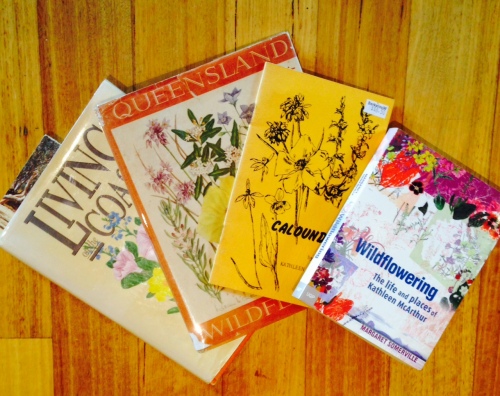My search for a subject for this month’s printmaking inspiration for my ‘year in bloom’ began with my looking for any of the flowering plants from Kathleen McArthurs’s book (The Bush in Bloom), however this month I came up with a blank. Her drawings for April include the Cooktown Orchid (Dendrobium bigibbum), Lily of the Valley Orchid (Dendrobium monophyllum) and also a native iris (Paterson sericea). While we have some orchids, none are in flower, and neither are (what I thought were) our native irises. It turns out that the ones growing on our property are not natives at all, but Dietes grandiflora which are from South Africa, and they are not in bloom anyway! And this led me to thinking about absences – things not present, things changing, things disappearing from our landscapes and also from our oceans.
This week our various screens and newsfeeds have been full of devastating images from the Great Barrier Reef, and reports of a massive coral bleaching event. This type of event has occurred before, but the issue is that they are occurring more regularly and experts are concerned about the coral’s ability to recover before another event. The scientists agree that an el nino event has exacerbated the heating of the oceans, but the underlying conditions are being influenced by climate change and the gradual rising of the water temperatures. The reef is under attack, but it is by no means the first time, and this leads me back to our wild/flower women – in particular to poet and activist Judith Wright.
Judith Wright, Kathleen McArthur and other pioneers of the Wildlife Preservation Society of Queensland were at the forefront of protests to protect the reef back in the 1960s. The WPSQ became aware of an application to mine limestone on the Great Barrier Reef at Ellison Reef, with claims being made that the area was comprised of dead coral. Judith Wright and Innisfail WPSQ president John Busst, worked with scientists to document and testify that the reef was indeed a living coral reef and they successfully petitioned for the mining application being rejected (WPSQ 2008). This and ongoing activism was fundamental to the declaration of the Great Barrier Reef marine park and the World heritage status of the region. In her book Coral Battleground (which was republished in 2014) Judith Wright says:
This story has no real beginning and no one knows what its end will be. It is a part of the history of the Great Barrier Reef, that great complex structure of coral reef and living organisms that stretches 1,200 miles along the coastline of Queensland…
… if the Great Barrier Reef could think, it would fear us more. We have its fate in our hands, and slowly but surely as the years go on, we are destroying those great ‘water-gardens’, lovely indeed as cherry-bough in flower under their myriads of varied animal lives.
So it seems the fate of the reef again is at risk. Reflecting on thoughts of absences, we need to ask ourselves and our politicians if we are willing to bid farewell to these unique ‘water-gardens’? Do we want to be the generation that stood by and witnessed these marine playgrounds become deserts? Or do we need to try a little harder to question what we do, who we are, what we believe is possible and what is important. There are a number of active campaigns regarding the reef, including those to prevent the dredging of the reef for coal terminals. Adding our voices to and supporting campaigns financially as well as doing what we can to keep climate change action on the agenda can all be everyday actions we are capable of. And perhaps we can also use the arts to keep these matters and the beauty and majesty of the reef right up front in the public and political face.
References
Judith Wright (1977/2014). The coral battleground. Melbourne: Thomas Nelson (North Melb: Spinifex Press)
WPSQ (2008). Historical Papers, Monograph 2 – Heart and Mind: WPSQ finding direction in the 60s. Brisbane: Wildlife Preservation Society of Queensland.






















